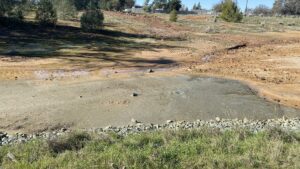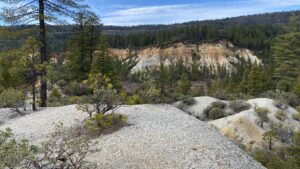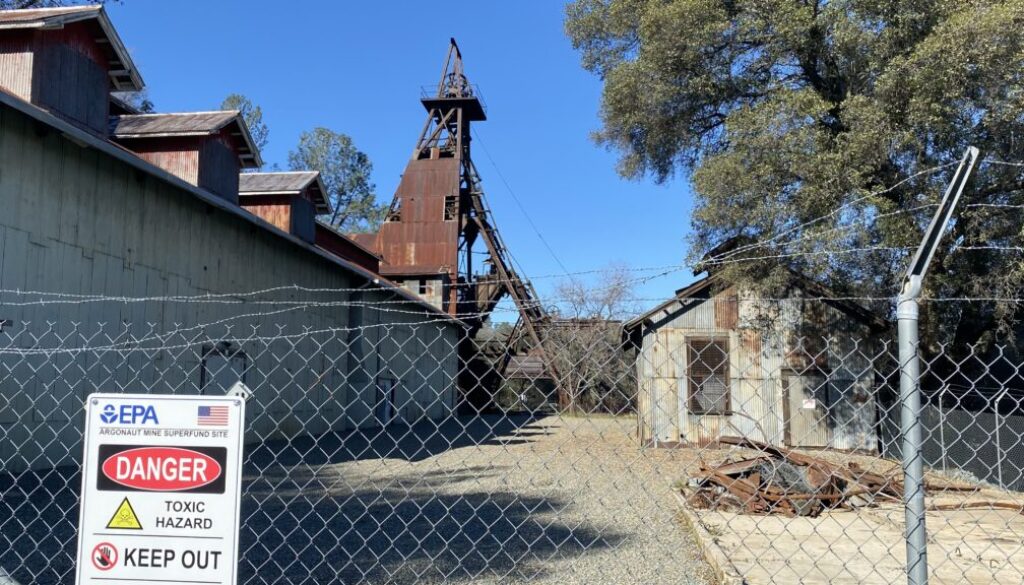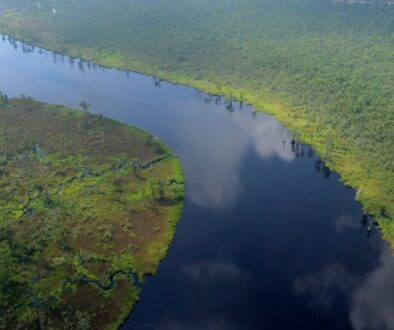Climate change brings new urgency to threats posed by abandoned California gold mines
By Leah Campbell
On the western slopes of the Sierra Nevada mountain range in California sits the small town of Nevada City, a historic Gold Rush community where prospectors once mined for riches in the creek that ran alongside town. Today, it’s a popular tourist destination known for its easy access to the picturesque Yuba River and the region’s famed ski resorts.
Belying the welcoming charm of Nevada City, just a few miles to the south lies a different sort of legacy – a 30-acre plot of toxic desolation known as the Lava Cap Mine where arsenic-laden waste from decades of gold and silver mining has contaminated area soils and water. In 1997, a log dam built to contain the debris collapsed in a winter storm and roughly 10,000 cubic yards of mine waste – enough to cover almost five football fields – washed through creeks and into a nearby lake.
For more than two decades now, the site has been on the Environmental Protection Agency’s (EPA) Superfund list, one of thousands of locations designated as posing “unacceptable risks to human health and the environment.” Clean-up efforts are still in progress at Lava Cap.
Lava Cap is among many abandoned hardrock mines strewn through what Californians call “Gold Country.” State and federal officials estimate that there are almost 50,000 such mines in California and more than 160,000 overall across the western United States. Not all are contaminated, but those that are continue to leach out toxic substances, experts say.
Cleanup of these sites takes years and costs millions of dollars. But now, climate change is creating new urgency amid fears that more frequent and volatile flooding and out-of-control wildfires will further spread the toxins.
“There’s been decades of research about remobilizing of mine waste by floods,” said Sheila Murphy, a hydrologist with the US Geological Survey (USGS) who has studied the impacts of extreme weather on mine-contaminated watersheds. “One of the issues is when these big floods then move the sediment into streams or reservoirs,” she said. “It’s just sitting there vulnerable to being remobilized over time.”

Murphy is just as concerned with fire as she is with floods. Changes to the soil, ash buildup, and the burn-off of vegetation after a fire means that fire-scarred lands are more prone to floods and mudslides, not just for a single season, but potentially for several years after a fire.
When it comes to the remobilization of contaminated mine waste because of flooding, “fire puts that on steroids,” Murphy said.
Dangerous to human health
Heavy metals such as arsenic and lead are often naturally occurring near gold deposits. Mining brings them to the surface where they can pose risks to people exposed to them.
Exposure to arsenic, for example, is known to cause reproductive issues, high blood pressure, and cancer. The EPA’s regional screening level – the ‘acceptable’ threshold for the concentration of a toxic substance – is 35 milligrams of arsenic per kilogram (mg/kg) of dirt. Samples taken from Lava Cap had concentrations over 1,000 mg/kg.
Arsenic isn’t the only concern. Miners often used mercury to bind with gold and create a heavier blend that was easier to capture. At hydraulic mines found across the region, workers used high-pressure water cannons to wash the slurries of rock and mud into mercury-lined sluice boxes. The gold would settle along the bottom, and the dense sludge – laced with mercury – would continue out of the box.
Malakoff Diggins, a state park about an hour north of Nevada City, was the state’s largest hydraulic mine. Today all that remains is an open pit with steep, crumbling slopes. It’s one of the largest sources of mercury to downstream rivers like the Yuba.

Significant amounts of mercury remain in reservoirs and waterways across California, slowing transforming into methylmercury, a highly toxic substance that can build up in fish tissue and cause severe neurological issues in humans. In Nevada County, many of the waterways have advisories to discourage some people from eating local fish because of mercury contamination.
Western mountain ranges such as the Sierra Nevada are expected to see more intense and frequent storms in the future. At mines, floodwaters can erode piles of waste rock, carrying contaminated dirt and sediment downstream. Rain can flow into old mining shafts and tunnels, bringing those contaminants to the surface.
Sites that rely on debris dams to hold back piles of dirt and mud full of mine waste pose a particular threat. Many were built to comply with some of the country’s first environmental regulations, such as the Caminetti Act, passed in the late 1800s to prevent mine waste from escaping downstream and poisoning farmland and rivers. More than a century later, many of those dams have decayed and aged, leaving them increasingly vulnerable to extreme weather.
One such example is situated 80 miles south of Nevada City in Jackson, California. A concrete dam built in 1916 stands at the edge of the former Argonaut Mine, which is also on the EPA’s Superfund list. In 2015, the US Army Corps of Engineers declared the dam structurally unsound and at risk of collapse in the event of a big storm. Jackson Junior High School and the small downtown would receive the brunt of any flood of waste.
The dam has been reinforced, and clean-up is ongoing. Government officials are also working to ensure the site is engineered to withstand future climate-related challenges. For example, the channel that will direct water around the site so it stays clean is being designed to withstand a 500-year storm.
It’s important to be prepared, said John Hillenbrand, project manager at the Argonaut Superfund site. “Five hundred years gives us a little more comfort,” he said.
A wake-up call
Longtime Nevada City resident Carrie Monohan, who works as program director of a local nonprofit focusing on mine cleanup, said reminders of the area contamination come with each new rain.
The USGS’s Murphy has participated in several projects that aim to quantify the impacts of fire and floods on mined watersheds in Colorado, which, like California, is expected to experience the one-two punch of rainstorms following fire more regularly in the future. She and her colleagues have studied a mining district outside of Boulder, Colorado, which was affected by the Fourmile Canyon Fire in 2010.
Arsenic levels at one of the team’s monitoring sites near the bottom of the watershed increased five times after just one storm several months after the fire. At another site, they recorded levels of arsenic more than seven times the EPA’s acceptable limit for drinking water.
A few years later, the Fourmile Creek watershed was affected by the unprecedented 2013 Colorado floods, which transported even more tons of dirt, mud, and soil rich in mine debris into Fourmile Creek. The researchers estimated that the flood produced the equivalent of hundreds of years’ worth of normal erosion in one go. Afterwards, levels of arsenic at the mouth of creek were almost ten times higher than at the top of the watershed.
Murphy says the extreme fire seasons of recent years have brought more attention to the impacts of mine waste on water quality.
“I think it’s really been a wake-up call for a lot of federal agencies that, ‘wow, yeah, this is a problem.’”
(Featured photo: A sign prohibiting entry to the old processing area where gold was dug up from under ground at Argonaut Mine in California. Photo credit: Leah Campbell.)
 EWG
EWG


